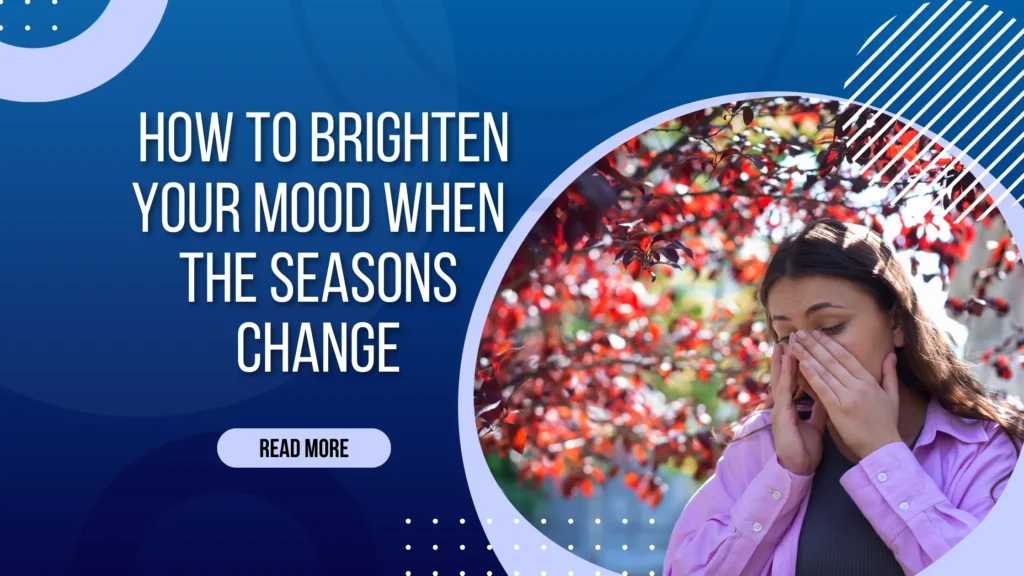Seasonal depression, commonly referred to as Seasonal Affective Disorder (SAD), is a type of depression that manifests at specific times of the year, with the late fall and winter months being the most prevalent periods for many individuals. This condition is thought to be closely linked to variations in natural light exposure, which can have a significant impact on the body’s internal clock or circadian rhythm.
During the darker months, reduced sunlight can lead to a drop in serotonin levels, a neurotransmitter that influences mood, which may contribute to feelings of sadness, lethargy, or irritability. Additionally, the lack of sunlight can disrupt melatonin production, affecting sleep patterns and overall well-being. Symptoms of SAD often include low energy, social withdrawal, changes in appetite, and difficulty concentrating. Understanding these connections between light exposure and mood is crucial for addressing the condition effectively, as treatments may include light therapy, medication, and lifestyle changes aimed at enhancing exposure to natural light.
Introduction
Seasonal Affective Disorder (SAD) is a type of depression related to changes in seasons. It often begins and ends at about the same time each year, typically when the seasons shift. While many people experience mood changes or “winter blues” during shorter days in the fall and winter, SAD involves more significant and lasting changes in mood, energy, and behavior that can disrupt daily life.
Key Features of SAD
Timing –
- Most commonly starts in late fall or early winter and subsides in spring or summer (winter-pattern SAD or winter depression).
- Less commonly occurs in the spring and summer (summer-pattern SAD or summer depression).
Types:
- Winter-Pattern SAD: Symptoms emerge in the fall, worsen through the winter, and improve in the spring and summer.
- Summer-Pattern SAD: Symptoms are less common but occur during the spring or summer and improve during the cooler months.
Causes::
Seasonal Affective Disorder (SAD) is believed to be caused by several factors, primarily linked to reduced exposure to sunlight during shorter days in the fall and winter. These factors include:
- Chemical Changes in the Brain: Reduced sunlight can disrupt the brain’s balance of neurotransmitters, such as serotonin, which affects mood. Lower serotonin levels have been associated with depression, including SAD.
- Increased Melatonin Production: Melatonin, a hormone that regulates sleep-wake cycles, is produced in higher amounts in darkness. During shorter, darker days, the body produces more melatonin, which can lead to increased sleepiness, fatigue, and disruptions in circadian rhythms.
- Circadian Rhythm Disruption: The body’s internal clock, or circadian rhythm, relies on light cues to stay in sync. With less daylight, the circadian rhythm can become misaligned, contributing to feelings of depression and lethargy.
- Vitamin D Deficiency: Sunlight is a key source of vitamin D, which plays a role in serotonin production. Reduced sunlight exposure during winter months can lead to lower vitamin D levels, potentially contributing to SAD symptoms.
Symptoms
- Increased sleep and daytime drowsiness – Feeling the need for more sleep than usual or experiencing persistent fatigue during the day.
- Loss of interest and pleasure in activities formerly enjoyed – A diminished ability to feel joy or enthusiasm in hobbies or daily activities.
- Social withdrawal and increased sensitivity to rejection – Avoiding social interactions and heightened emotional reactions to perceived criticism or rejection.
- Grouchiness and anxiety – Irritability and feelings of tension or unease.
- Feelings of guilt and hopelessness – Experiencing negative self-reflection and a bleak outlook on life.
- Excessive tiredness (fatigue) – Persistent physical and mental exhaustion, even after rest.
- Decreased sex drive – Reduced interest in sexual activity or intimacy.
- Decreased ability to focus – Trouble concentrating or staying mentally sharp.
- Trouble thinking clearly – Difficulty making decisions or processing information.
- Increased appetite, especially for sweets and carbohydrates – Craving high-sugar or starchy foods, leading to changes in eating habits.
- Weight gain – Associated with increased caloric intake and reduced physical activity.
- Physical problems, such as headaches – Experiencing bodily discomfort or pain, potentially linked to stress or hormonal changes.
Risk Factors:
Seasonal affective disorder is diagnosed more often in women than in men. SAD occurs more frequently in younger adults than in older adults.
Factors that may increase your risk of seasonal affective disorder include:
- Low levels of vitamin D – Some vitamin D is produced in the skin when it’s exposed to sunlight. Vitamin D can help to boost serotonin activity. Less sunlight and not getting enough vitamin D from foods and other sources may result in low levels of vitamin D in the body.
- Family history – People with SAD may be more likely to have blood relatives with SAD or another form of depression.
- Having major depression or bipolar disorder – Symptoms of depression may worsen seasonally if you have one of these conditions.
- Living far from the equator – SAD appears to be more common among people who live far north or south of the equator. This may be due to decreased sunlight during the winter and longer days during the summer months.
Even the darkest winters have light—acknowledge your feelings, and let hope guide you through seasonal depression.
Diagnosis
The diagnosis of Seasonal Affective Disorder (SAD) involves a comprehensive evaluation to differentiate it from other types of depression or mental health conditions with similar symptoms. This process typically includes:
Physical Exam
- A healthcare provider performs a physical examination and discusses your overall health.
- They may look for physical health problems that could be causing depressive symptoms.
Lab Tests
- Blood tests, such as a complete blood count (CBC), may be conducted.
- Thyroid function tests may also be performed to rule out hypothyroidism or other thyroid-related issues.
Psychological Evaluation
- A mental health professional assesses symptoms, thoughts, feelings, and behavioral patterns.
- Questionnaires or screening tools may be used to gain a clearer understanding of depressive symptoms specific to SAD.
Prevention:
Preventing Seasonal Affective Disorder (SAD) focuses on minimizing risk factors and managing early symptoms to prevent them from worsening. Strategies for prevention include:
Light Exposure
- Spend time outdoors, especially in the morning, even during colder months.
- Consider using a light therapy box starting in the fall to mimic natural sunlight and regulate your circadian rhythm.
2. Healthy Lifestyle
- Exercise regularly: Physical activity can boost mood and energy levels.
- Balanced diet: Focus on foods rich in nutrients to support mental health.
- Adequate sleep: Maintain a consistent sleep schedule to improve energy and mood.
3. Stress Management
- Practice relaxation techniques such as yoga, meditation, or deep breathing exercises.
- Set aside time for hobbies and activities that bring joy.
4. Social Connections
- Stay connected with family and friends to reduce feelings of isolation.
- Join community activities or support groups for mutual encouragement.
5. Plan Ahead
- If you’ve experienced SAD in the past, start light therapy or other preventive measures in the early fall before symptoms develop.
- Work with a mental health professional to develop a personalized prevention plan.
6. Professional Guidance
- Regular check-ins with a therapist or counselor can help monitor mood changes.
- Medication or supplements, such as vitamin D, may be recommended based on individual needs.
TREATMENT:
- Exposure to Sunlight: Spending time outdoors or near windows with natural light can ease symptoms, particularly in winter depression.
- Light Therapy: If natural sunlight isn’t accessible, using a specialized light therapy box as directed by a healthcare provider can be beneficial.
- Psychotherapy: Cognitive-behavioral therapy (CBT) or interpersonal therapy can help reframe negative thoughts, improve relationship skills, and manage stressors.
- Antidepressants: Prescription medications might be necessary to correct chemical imbalances related to SAD. These should be prescribed and monitored by a healthcare provider.
SELF-CARE STRATEGIES
- Seek Professional Help: If you suspect depression, consult a healthcare provider promptly.
- Set Realistic Goals: Break tasks into smaller, manageable steps, and prioritize them without overwhelming yourself.
- Engage Socially: Spending time with supportive people and sharing your feelings can reduce isolation.
- Participate in Enjoyable Activities: Hobbies like gardening, attending social events, or helping others can boost mood.
- Exercise Regularly: Physical activity improves overall mood and well-being.
- Follow a Balanced Diet: Healthy eating supports mental health.
- Avoid Substances: Alcohol and illegal drugs can exacerbate depression symptoms.
- Delay Major Decisions: Avoid making life-altering changes until your mood stabilizes.
- Be Patient: Recovery is gradual—focus on small improvements and positive thoughts over time.
CONCLUSION:
This paper provides an overview of Seasonal Affective Disorder (SAD) and its subtype, S-SAD, commonly referred to as the “winter blues.” It explains SAD in the context of DSM-5 criteria, symptoms, history, and prevalence. People with SAD often experience feelings of sadness and low energy to the point where their ability to function is impaired. Those living in northern latitudes are particularly at risk. The Seasonal Pattern Assessment Questionnaire (SPAQ) is a useful tool, allowing individuals to self-report their Global Functioning Scores, which reflect their perception of the severity of the disorder.
So, if you are suffering from SEASONAL DEPRESSION feel free to visit our clinic at Vishudh Kaya Pain Relief and MULTISPECIALITY Clinic, Kharar.
Frequently Asked Questions
Yes, vitamin D may help with seasonal depression, also known as Seasonal Affective Disorder (SAD). SAD is often linked to reduced sunlight exposure during the fall and winter months, which can lower vitamin D levels in the body. Since vitamin D plays a role in mood regulation and brain health, its deficiency is believed to contribute to depressive symptoms.
Seasonal anxiety disorder, or SAD, is a complicated disorder where a person tends to experience more anxiety during certain months. Usually, ly it’s the winter months/colder months, but some people seem to experience SAD during the summer months.
Depression isn’t caused by a single deficiency, but certain nutritional deficiencies and biochemical imbalances have been linked to a higher risk of depression or worsening of its symptoms.


